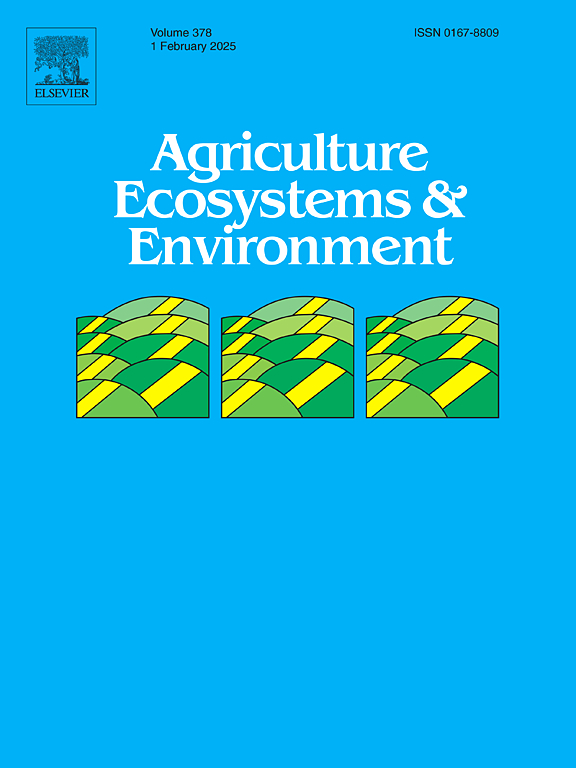Nitrogen and phosphorus supply controls stability of soil organic carbon in alpine meadow of the Qinghai-Tibetan Plateau
IF 6
1区 农林科学
Q1 AGRICULTURE, MULTIDISCIPLINARY
引用次数: 0
Abstract
Anthropogenic activities have significantly increased soil nutrient availability, thereby influencing ecosystem processes and functions, particularly in nutrient-limited ecosystems like alpine grasslands. Despite substantial efforts dedicated to comprehending the responses of plant productivity and community composition to nitrogen (N) and phosphorus (P) addition, our understanding of the effects of nutrient additions on soil organic carbon (SOC) remains limited. Here, we implemented a 12-year manipulative fertilization study with three levels (0, 10 and 30 g m‐2) of N, P, and NP fertilization (N and P fertilization at a ratio of 1:1) in an alpine meadow of the Qinghai-Tibetan Plateau. Results showed that N and P additions increased the content of soil organic carbon compared with control. Under the same fertilization conditions, soil organic carbon content increased with the increases of fertilization level, and reached the maximum under N30 treatment (P < 0.05). N and P additions promote the labile carbon (polysaccharide-C and alcohol-C) consumption and the stable carbon (aromatic C and aliphatic-C) enrichment, consequently, it improved the stability of soil organic carbon and facilitated the sequestration of soil organic carbon in alpine meadow. The highest stability of soil organic carbon presented in NP30 treatment compared with others treatments. Indicating that NP addition simultaneously can promote the stability of SOC more. The structural equation modeling (SEM) revealed that under the N and P additions treatments, the main factors affecting soil organic carbon stability were soil organic carbon, pH, ratio of carbon and phosphorus (C:P), ratio of carbon and nitrogen (C:N), soil available N:P (AN: AP), available phosphorus (AP), soil available C:N (AC:AN), soil water content (SWC), total nitrogen (TN), available (AN). Overall, nitrogen and phosphorus additions altered soil physicochemical properties as well as the composition of functional groups within soil organic carbon in alpine grasslands, ultimately promoting its accumulation while also impacting both the content and stability of soil organic carbon.
氮磷供给控制青藏高原高寒草甸土壤有机碳的稳定性
人类活动大大增加了土壤养分的可用性,从而影响了生态系统的过程和功能,尤其是在像高寒草原这样养分有限的生态系统中。尽管我们为了解植物生产力和群落组成对氮磷添加的响应做出了大量努力,但我们对养分添加对土壤有机碳(SOC)影响的了解仍然有限。在这里,我们在青藏高原的一片高寒草甸上进行了一项为期 12 年的操纵性施肥研究,采用了三种施肥水平(0、10 和 30 g m-2)的氮肥、磷肥和氮磷钾肥(氮肥和磷肥的比例为 1:1)。结果表明,与对照组相比,氮肥和磷肥的添加增加了土壤有机碳的含量。在相同施肥条件下,土壤有机碳含量随施肥量的增加而增加,在 N30 处理下达到最大值(P < 0.05)。氮和磷的添加促进了高寒草甸土壤中可迁移碳(多糖-C 和醇-C)的消耗和稳定碳(芳香族碳和脂肪族碳)的富集,从而提高了土壤有机碳的稳定性,有利于土壤有机碳的固碳。与其他处理相比,NP30 处理的土壤有机碳稳定性最高。这表明同时添加氮磷钾更能促进土壤有机碳的稳定。结构方程模型(SEM)显示,在添加氮和磷的处理中,影响土壤有机碳稳定性的主要因素有土壤有机碳、pH值、碳磷比(C:P)、碳氮比(C:N)、土壤可利用氮磷比(AN: AP)、可利用磷(AP)、土壤可利用碳氮比(AC:AN)、土壤含水量(SWC)、全氮(TN)、可利用氮(AN)。总之,氮和磷的添加改变了高寒草地土壤的物理化学性质以及土壤有机碳功能群的组成,最终促进了土壤有机碳的积累,同时也影响了土壤有机碳的含量和稳定性。
本文章由计算机程序翻译,如有差异,请以英文原文为准。
求助全文
约1分钟内获得全文
求助全文
来源期刊

Agriculture, Ecosystems & Environment
环境科学-环境科学
CiteScore
11.70
自引率
9.10%
发文量
392
审稿时长
26 days
期刊介绍:
Agriculture, Ecosystems and Environment publishes scientific articles dealing with the interface between agroecosystems and the natural environment, specifically how agriculture influences the environment and how changes in that environment impact agroecosystems. Preference is given to papers from experimental and observational research at the field, system or landscape level, from studies that enhance our understanding of processes using data-based biophysical modelling, and papers that bridge scientific disciplines and integrate knowledge. All papers should be placed in an international or wide comparative context.
 求助内容:
求助内容: 应助结果提醒方式:
应助结果提醒方式:


